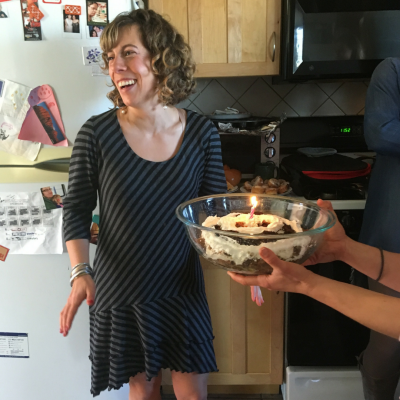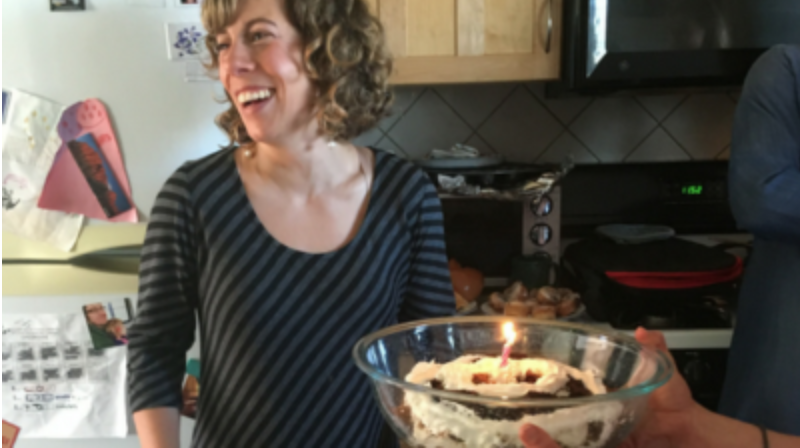We’ve just finished lunch—bright orange macaroni and cheese for the kids and quiche muffins for the grown-ups. From a distance I watch the kids devour cupcakes. My daughter, the birthday girl, sits at the head of the table, her shining blonde curls springing from underneath a sparkly paper tiara. Like me, she loves sweets. Unlike me, joy is the only emotion she’s ever associated with dessert.
I have spent decades eating my treats with a generous serving of guilt.
But as the chaos of a dozen sugared-up kindergartners swirls around me, I bite into a Funfetti cupcake and all I taste is happiness. The yellow cake is buttery heaven. The rainbow confetti pieces explode into sharp sweetness as they crunch between my molars. What’s missing is the bitter aftertaste of regret.

A couple of weeks before, I’d started using Macrostax. While the math part of my brain was tense from all the counting and measuring, another part of my mind softened. Counting macros meant I was no longer subject to my personal calculus: Had I exercised enough? Was the occasion special enough? Did I deserve it? Instead, I only had to determine whether the cupcake fit into my macros for the day using elementary school math.
Using Macrostax isn’t about “being good” or “eating clean.” And it’s certainly not about restriction. I was shocked to discover I could eat plenty of food (including cereal, toast, and all the other “bad carbs” I used to avoid) and enjoy the way my clothes fit. The equation is based on numbers, leaving no room for judgment or shame.
For decades, I’ve been consumed by the notion that food could make me “bad” or “good.” I was 15 when I learned to fear food.
“I’m so bad!” my best friend exclaimed as we walked from our junior class meeting to first-period pre-calculus. “I ate, like, an entire pizza last night.”
Only a few months before, I’d listened to her “confessions,” nodding my head in feigned understanding. Privately, I’d thought the only way pizza could make you feel bad was by giving you a stomachache if you ate too much of it. Eventually, though, I understood exactly what she meant. Maybe it was the fact that she’d turned food guilt into an Olympic sport and I was a front-row spectator. Maybe it was all the issues of Seventeen I’d study when they came in the mail each month. Or maybe equating my self-worth with the size of my body was just an inevitability of being a girl.
“Do you have any idea how many grams of fat are in one slice of pizza?” my best friend asked.
I tried to console her. “You run so much. You’ll burn it off.”
I’d just finished my breakfast, an untoasted bagel with nothing on it. Fresh from a local bakery, it was crusty on the outside, warm and chewy on the inside. Not only did it taste like a doughy piece of heaven, it was healthy and I ate it every day. “Low-carb” had yet to become a household term. In the mid-90’s fat was the enemy.
A few years later, with the advent of the Atkins and South Beach diets, I felt foolish for fearing fat; carbs were what I should have been leery of. In my 20’s I tried the Zone Diet. Though bagels were off-limits, I made occasional allowances; training for my first marathon, I rewarded myself with a bagel (and cream cheese!) after my long run of ten to 20 miles. While “in the zone” I alternated between applauding myself for being “good” and obsessing about what I’d eat if I went out with friends. I didn’t realize I was obsessed with food because I wasn’t eating enough of it.
Even after I ditched The Zone diet, my relationship with food remained fraught. If I stuck to eating lean protein, vegetables, and “good carbs” like brown rice and sweet potatoes, I could relax. Meanwhile, “bad” foods stirred my cauldron of anxiety. I tallied my favorite foods—a toasted salt bagel with cream cheese, a hot slice of wood-grilled Hawaiian pizza, a wedge of homemade coconut cream pie—on my mental ledger to determine whether I could “afford” them. But no matter what my calculations yielded, I was consumed by worry and guilt.
I now know food is just food—it doesn’t have the power to make a person good, bad, or anything in between. And while this is easy to comprehend intellectually, it is hard to change the habits I’ve ingrained over the years.
Macrostax doesn’t force me to examine my personal baggage around food; it only asks me to keep track of my choices and to make decisions based on numbers, which are based on science. I simply eat a certain number of grams of carbs, fat, and protein to hit my target macros each day. And I can enjoy a glass of wine, a bowl of cereal, or a cupcake without starving myself to fit them into my macros. And best of all, in five weeks I’d lost three pounds and four inches (which is significant for my five foot frame), without feeling deprived.
At my daughter’s birthday party I enjoyed my cupcake the same way my daughter enjoyed hers—without an ounce of guilt. For the first time in my adult life, a cupcake was just a cupcake, not a gateway to gluttony or something to “earn.” I’m not saying my relationship with food is perfect. But I’d say breaking my decades-old habit of basing my self-worth on my food choices is an excellent start.
Pam Moore is a freelance writer, run coach, and Macrostax member.



